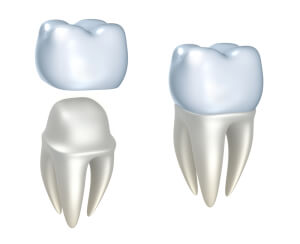Porcelain and Zirconia Crowns

Porcelain Dental Crown
Dental Crowns are considered the building blocks of smile rehabilitation. Just like veneers, Dental Crowns can be used to improve the smile. Crowns are a great way to improve the teeth that have gaps, discoloration, or worn due to grinding and clenching. They are used when teeth have become decayed, weakened, or cracked. Dental Crowns are also commonly known as “caps”, which slip over the surface of the tooth, covering and strengthening it. Tribeca Advanced dentistry only uses metal-free crowns, which are either zirconia or porcelain. The new CAD/CAM technology allows us to make crowns that do not require removal of significant amount of tooth structure, which is the case of the old type of porcelain fused to metal or gold crowns.
Our porcelain crowns can be thought as “360 degree” veneers that only replaced damaged or decayed part of the tooth. The crowns are color-matched to blend in with your surrounding teeth for a natural look and feel. To ensure that your crown has a perfect fit and placement, we use leading computer imaging software to design and plan them. You can see some of our actual Dental Crown cases in our Smile Gallery.
When crowns are needed for cosmetic rehabilitation of teeth? Should I use veneers?
Both Dental Crowns and Veneers are associated with a smile makeover and we offer both. However, when Dr. Malkin often deals with more complicated treatments that need significant aesthetic rehabilitation of one’s teeth, Dental Crowns are often preferred. These cases often include patient that have worn out teeth due to grinding, clenching, or acid destruction. These types of patients require Crowns instead of Veneers to protect the teeth from further destruction. Sometimes, they have deformed facial features due to worn out teeth: some patients do not show their teeth when they smile, or the lower part of their face is collapsed giving them older appearance. Dental Crowns not only help to protect the teeth from further damage, but also help to lengthen the teeth and give patients a more youthful appearance.
Another reason to prefer Crowns to Veneers is their strength. They are used for patients that grind or clench their teeth. These patients may be in danger of breaking or chipping their Veneers.

Before and after pictures of a 50-year old patient lengthening the teeth and correcting the underbite with dental crowns.
58 year patient had chipped and worn out teeth. It was restored with Dental Crowns in 2018.
How our Zirconia and Porcelain Crowns (Emax) different from traditional metal-ceramic crowns?
At Tribeca Advanced Dentistry, we often hear patient worrying about getting Crowns as they are afraid that their teeth will be shaved off to small stumps and will require root canals to get Crowns put over them. However, this view is no longer true when we use modern CAD/CAM technology to make our Zirconia, Porcelain (Emax) Crowns. The new technology allows us to remove a minimal amount of tooth structure to put a crown over a tooth. The only tooth structure that is removed is damaged by wear and decay, or a part of a defective old filling. Only the teeth that are severely damaged by caries require to have root canals and due to bacteria destruction rather than the amount of tooth structure removed to put the crown over the tooth. The crown can be though as a “360-degree Veneer” with only minimal tooth structure removal.
What material do we use for Dental Crowns?
We use Zirconia or Emax crowns due to their superior aesthetics and fit over conventional porcelain crowns. The do not produce a dark line at the gumline that people associate with crowns. This dark line is produced by metal showing through the porcelain of the metal ceramic crowns.
Zirconia Crowns are tooth colored metal free crowns that we usually utilize on the back teeth of the mouth because they have a superior strength. On some rare occasions we use them for anterior teeth in case of severe clenches and grinders. Zirconia Crowns are manufactured using computerized CAD/CAM technology and have a superior strength and precise fit.
We use Emax/Porcelain Crowns in highly aesthetic cases and for the anterior teeth. They are also strong enough to use for the back teeth if a patient is not suspected of grinding their teeth. These crowns are also manufactured using computerized CAD/CAM technology and have a very precise fit in addition to the ability to seamlessly blend with other natural teeth.
What is a typical Dental Crown procedure?
We install Dental Crowns for two reasons: protect and repair some of the broken teeth in the mouth or as a part of an extensive cosmetic rehabilitation.
If we install crowns to repair or protect some of the teeth in the mouth, the process is quite simple and only takes two appointments. During the first appointment, the tooth is prepared for the crown and a mold is taken of the prepared tooth. A temporary crown is placed on the tooth so that patient can function normally with a few minor restrictions. The impression is sent out to our dental laboratory where the new crown is fabricated. At the second appointment, the crown is installed, often without even requiring numbing the tooth.
If we place crowns to perform a complex aesthetic and functional reconstruction, the process is different. The first step of the process is to discuss with the patient their aesthetic goals: what kind of smile they want to achieve. Visual aids help here – Dr. Malkin encourages patients to bring old pictures when their smile was at their best, or maybe bring a picture of a celebrity’s smile that you want to emulate. After this initial consultation, we will inform you of all the fees associated with this procedure, and you will get a written treatment plan specifying your fees and the schedule payment. Then, we will take pictures of your teeth from many different angles, which will help us determine what teeth structure will look best. We will also make a mold of your teeth and take some other measurements. All these pictures and measurements are sent to a dental lab. Here, a mock-up of the crowns is created that can be presented to you as a sample. For some patients, this mock-up can even be placed in their mouths to provide an extremely accurate projection of what their appearance will look like post-veneer.
The next step is for the patient to come in for the actual procedure of preparing for a crown. Depending on the scope of the procedure, this can become lengthy. We can arrange for an anesthesiologist to come in for patients who are anxious about drawn-out dental procedures, and we also offer sedatives and relaxants at no charge. Nitrous gas is available as well. To prepare for Dental Crowns, damaged by wear and caries, part of the tooth is removed with care to leave as much tooth structure as possible. After that, temporary crowns are placed on the teeth. These temporary crowns are made based on the lab mock-up, so they resemble very closely the final crowns. In three to seven days after placing temporary crowns, once all numbness has worn off, the patient returns and we take pictures of how the temporary crowns look and record any thoughts or concerns the patient has with the aesthetics of the crowns at this stage (this information is used to improve the final crowns). It takes about 2 to 3 weeks for the dental lab to fabricate the final crowns. Once we receive the final crowns, during the next appointment, the patient is numbed again, and the final crowns are tried on. The patient gets a chance to note any changes they want to make (in this case, the final crowns are sent back to the lab for alterations). When the patient is satisfied, the crowns are cemented. After cementing, in 2 to 4 hours the final crowns are set, and the process is complete.
Dental Crown Maintenance
After your crown are installed, you may experience some initial discomfort or sensitivity along with some heat or cold sensitivity. In this case, we will recommend some specially formulated toothpaste for sensitive teeth. This sensation will soon go away.
Over time, there is always the risk that your Porcelain Crown may chip, loosen, or fall off. If this occurs, we will help you solve the problem quickly as we stand by our work and will repair your crown. On average, a crown will last between 5 and 15 years. This depends on the amount of wear and tear the crown receives and your personal hygiene. If you have a habit of grinding or clenching your teeth, chewing on ice, chewing your fingernails, or biting on other hard objects, or you tend to open packaging with your teeth, your Dental Crown may last less.
Its best to treat your crown like you would treat your natural teeth. That is to say that you need to practice good oral hygiene such as brushing twice a day, flossing once a day, and using antibacterial mouth rinse. It is strongly advised that you get dental cleaning every 6 or 3 months depending on your periodontal health. This prevents crowns from developing cavities around them.
After your crown is installed, you may experience some initial discomfort or sensitivity along with some heat or cold sensitivity. In this case, we will recommend some specially formulated toothpaste for sensitive teeth. This sensation will eventually go away.


